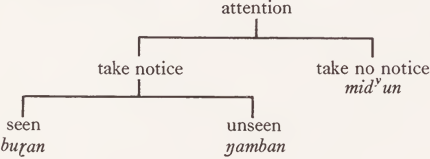


 Grammar
Grammar
 Tenses
Tenses
 Present
Present
 Past
Past
 Future
Future
 Parts Of Speech
Parts Of Speech
 Nouns
Nouns
 Verbs
Verbs
 Adverbs
Adverbs
 Adjectives
Adjectives
 Pronouns
Pronouns
 Pre Position
Pre Position
 Preposition by function
Preposition by function 
 Preposition by construction
Preposition by construction
 Conjunctions
Conjunctions
 Interjections
Interjections
 Grammar Rules
Grammar Rules
 Linguistics
Linguistics
 Semantics
Semantics
 Pragmatics
Pragmatics
 Reading Comprehension
Reading Comprehension|
Read More
Date: 2023-06-11
Date: 2024-08-12
Date: 15-2-2022
|
The negative particle, gulu, can be looked upon as a semantic operator, that effectively replaces a feature in a semantic description by another feature from the same system. A simple example will illustrate this.
In text XXXIb, a girl goes out after dark in search of a mythical spirit, despite repeated warnings not to. There is in the text a pattern of semantic replacement1 involving essentially gulu ŋamban (bala bayumanganu guwal) ‘ didn’t listen (to what they were all saying) ’ and midyuganinyu ‘ repeatedly took no notice ’. In this instance the semantic replacement marks a relation of effective synonymy (in a particular context): gulu ŋamban has the same meaning as would midyun; midyuganinyu merely repeats, with the addition of -ganiy ‘kept on doing it’.
The dependency tree for set 4 is:

Now we are regarding gulu as an operator that replaces a feature in a semantic description by another feature from the same system (the other feature if it is a binary system). So that here gulu plus (attention, take notice, unseen; tr) is effectively (attention, take no notice; tr): gulu operates on feature ‘ take notice’, replacing it by ‘ take no notice ’ (no choice from system (seen, unseen} is possible after a ‘ take no notice ’ choice). However gulu ŋambart ‘ didn’t hear ’ and buɽan an ‘ saw ’ have also been observed in semantic replacement relation in Dyirbal texts. In this case gulu plus (attention, take notice, unseen; tr) is effectively (attention, take notice, seen; tr): gulu leaves alone ‘take notice’ but operates on ‘unseen’, replacing it by ‘seen’.
Generally, gulu ‘not’ can operate on any feature in a semantic description. Its precise operation in a particular instance can be inferred from semantic oppositions and replacements in the text (contextual correlations in the sense of Dixon 1965.111-7), or from the situational or other information available to a listener.
1 That is, there is a replacement correlation - see Dixon 1965.115-7 ff.; and compare n. a, p. 453 and n. a, p. 456, above.
|
|
|
|
4 أسباب تجعلك تضيف الزنجبيل إلى طعامك.. تعرف عليها
|
|
|
|
|
|
|
أكبر محطة للطاقة الكهرومائية في بريطانيا تستعد للانطلاق
|
|
|
|
|
|
|
العتبة العباسية المقدسة تبحث مع العتبة الحسينية المقدسة التنسيق المشترك لإقامة حفل تخرج طلبة الجامعات
|
|
|